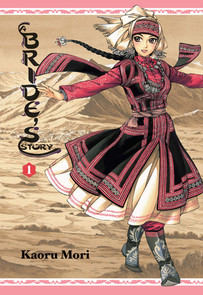Review
by Rebecca Silverman,A Bride's Story
GN 1
| Synopsis: |  |
||
In nineteenth century Central Asia, 20-year-old Amir is sent from her nomadic tribe to marry 12-year-old Karluk, the son of a city-dwelling family. The two learn to cope with both their age gap and different ways of life as they grow closer. |
|||
| Review: | |||
If there is anything that absolutely cannot be denied about Yen Press' English edition of Kaoru Mori's latest work, it is that this is a gorgeous book. Both manga fans and bibliophiles can delight in the treatment this volume has gotten: a hardcover with a full color paper jacket. The vibrant image of Karluk's family on the back cover and rear flap provides both a glimpse of what the inside art offers (albeit in black and white) while introducing us visually to the story's major players. You pay for it - $16.99 – but it's the kind of book that will have people on the train asking what you're reading. That said, this is not a story for everyone. Some readers have already been turned away by the synopsis above on the basis of the large age gap between husband and wife. And that gap is obvious – Amir is drawn as a fully developed woman and Karluk looks like the child he is. The story opens with their first glimpses of each other: Amir's shocked face as she lifts her veil and Karluk's stunned expression may mirror the reactions of readers. However, Amir quickly breaks into a smile, exclaiming, “Oh my!” At this point squeamish readers may start to worry. There is, however, little to fret about. Amir and Karluk share one chaste kiss, and the age gap is rarely referenced in the text. When it is, it's more in the context of Amir's limited childbearing years, something more cultural than sexual. Karluk's older sister is around Amir's age and has three elementary-aged children, suggesting that she had them in early puberty. This bears out the oddity of Amir and Karluk's match within the story's world, and it really ends there. If you can get past the visual reminders of their differing ages, there is not much to stop you from reading this book, no matter how fastidious you are. Despite a brief indication at the end of chapter one and revisited in chapter four, this book is very thin on plot. Chapter stories include learning that Amir can hunt with a bow and arrow, visiting Karluk's nomadic uncle, and a little boy sneaking out to watch a woodcarver, and, naturally, sheep-herding. This is not a fast-paced, thrilling read. In fact, it feels more like an anthropological text in manga form than a full-fledged story, a sense compounded by the bizarre inclusion of an anthropologist character. But what an anthropological text it is. Mori's art, detailed in her earlier work, has achieved new heights. Everyone's clothing is richly embroidered, and you can feel the weight of the fabric in the pictures. The Asian steppes are drawn so vividly you can smell the grass. And that woodcarving chapter? The depth, texture, and time are all palpably evident. This art is a labor of love and it is impossible not to delight in it. Though there is little action in the story, where it occurs it is well drawn. One particularly striking scene has Amir going from standing to sitting on horseback. You can hear the rustle of clothing and the thump of her hitting the saddle. Ultimately, this is a visual book. Despite the scarcity of text, it takes a long time to read in order to fully absorb all of the details in the art. Very few characters are given names within the story (Mori provides a chart in the back for the curious), and those of you familiar with Middle Eastern names may be thrown by the fact that “Amir” is traditionally a masculine one. There is very little romantic content for a book with “bride” in the title, but given the age difference between bride and groom, that may be for the best. Though it is worth mentioning that Amir is a very emotionally young twenty, while Karluk is a mature twelve. When all is said and done, this is not for the easily bored. But if you have an interest in Asian culture outside of China, Korea, and Japan, appreciate detailed artwork, and are willing to give a series a volume or two to get going, don't miss this treat. Even if Amir and Karluk don't win your heart, the world of the story will. |
|
The views and opinions expressed in this article are solely those of the author(s) and do not necessarily represent the views of Anime News Network, its employees, owners, or sponsors.
|
| Grade: | |||
Overall : B
Story : C
Art : A
+ Exquisitely detailed artwork, careful research, and generally likeable characters make this a soothing read. |
|||
| discuss this in the forum (26 posts) | | |||
| Production Info: | ||
|
Full encyclopedia details about Release information about |
||